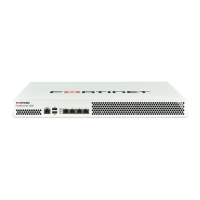Troubleshooting Page 136 FortiRecorder 2.4.2 Administration Guide
be finished or times out, and therefore TCP connections will persist in the session table for a
much longer time.
If you still do not see the sessions that you expect, verify that your firewall or router allows traffic
to or from those IP addresses, on all expected source and destination port numbers (see
“Appendix A: Port numbers”).
If you see sessions with the FortiRecorder web UI or CLI that should not be allowed to exist, be
sure to configure all accounts’ Trusted hosts setting.
See also
• NVR configuration
• User management
Resolving IP address conflicts
If two or more devices are configured to use the same IP address on your network, this will
cause a problem called an IP address conflict. Only one of those identically addressed devices
can have IP-layer connectivity at a given time. The other will be ignored, effectively causing it to
behave as if it were disconnected. (If multiple devices were to use the same IP address, routers
and switches would not be able to determine with certainty where to deliver a packet destined
for that IP address. To prevent this, routers and switches will only let one of the devices use the
IP.)
Typically IP conflicts are caused when either:
• you have accidentally configured 2 devices with the same static IP address
• you have accidentally configured a device with a static IP address that belongs to the DHCP
pool
• 2 DHCP servers accidentally have pools in the same range of IP addresses, and are each
independently assigning their clients the same IPs
Your cameras, of course, have no screen, and cannot display any IP address conflict error
message. However, you may notice symptoms such as interrupted video streams whenever a
new device connects to the network or reboots.
If you have configured your FortiRecorder NVR’s built-in DHCP server, first verify that it is not
using the same DHCP pool as another DHCP server on your network. Next, you can use the CLI
to determine whether MAC addresses from other devices’ network adapters have stolen IP
addresses that should belong to your cameras. See “Unauthorized DHCP clients or DHCP pool
exhaustion”. If, however, you have transitioned your cameras to use static IP addresses, you
must use another method.
• Use the ARP table of either your FortiRecorder NVR (see “Examining the ARP table”) or
router to determine which MAC address (and therefore which computer/device’s network
adapter) has taken the IP address.
• If a computer is using the same IP address as another device, such as your cameras, it may
periodically complain of an IP address conflict. This computer may be the source of the
conflict.
Once you have found the source of the problem, configure that computer or device to use a
unique IP address that is not used by any other device on your network.
See also
• Configuring the DHCP server

